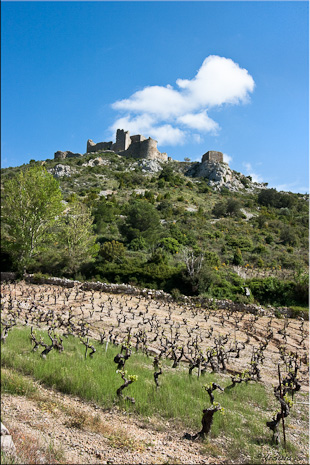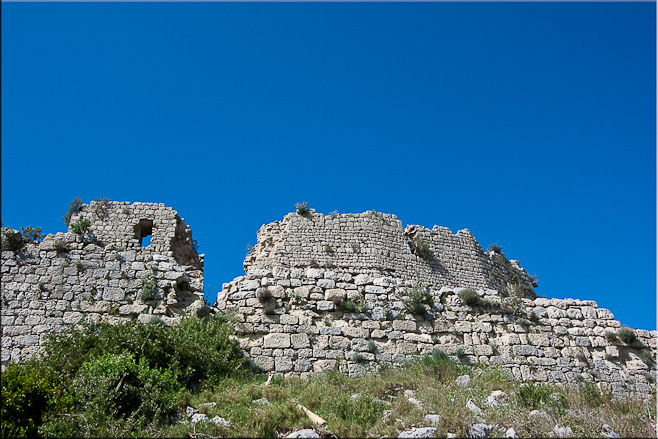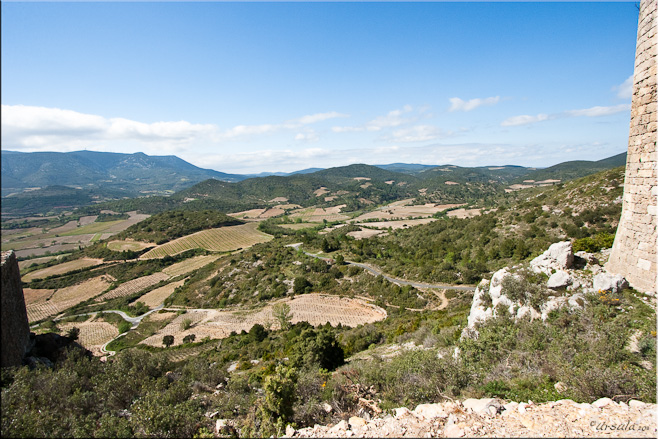
Vines, Garrigue and Castles: This is the Corbières
I can’t help but love a country that is passionate about food, wine and walking. While ‘walking’ may not be the first thing that comes to mind when you think of France, the French take their walking trails seriously. The country is criss-crossed by roughly 177,030 kilometres of marked, mapped and well-maintained paths.
The Institut Géographique National (IGN), an official government agency, produces detailed maps in varying scales, and the Féderation Française de la Randonnée Pédestre (FFRP), or ‘French Long Distance Walking Association’, comprised of over 2000 local clubs, maintains the tracks and publishes guide books. With a map, a compass and some notes, it is possible to plan a walking tour (une randonnée) from village to village, staying in local hotels and bed-and-breakfasts, almost anywhere in the country.
Last month, my husband and I spent two weeks eating, drinking and walking our way across a tiny portion (only 0.1%!) of this vast network of trails: we traversed about 200 kilometres of south-eastern France, following the Sentier Cathare (the Cathar Way) through the Pyrenees from Tuchan in Langudoc-Roussillon to Foix in the Midi-Pyrénées. We did it the easy way: we used an agent. We had walking notes in English; our accommodation was pre-booked; and the majority of our baggage was transported for us. Even so, the walk lived up to its ‘moderately strenuous’ rating, with a lot of daily ups and downs. It is an area of natural beauty with a poignant history. Over the next few weeks, I hope to share some of this magnificent region with you.
Trip Notes: Day 1: Arrive in the pretty town of Tuchan for overnight at Hostellerie du Mont Tauch.
I wouldn’t have called Tuchan a ‘pretty town’, but it is in a picturesque location: in the Corbières – a wild, mountainous region where ‘garrigue’, that wonderfully fragrant Mediterranean scrubland, alternates with vineyards and rocky outcrops. Because of our previous experience of arriving on a Monday when the hotel is closed, I made sure we would arrive on a Sunday instead. Train from Clermont-Ferrand to Nîmes; overnight in Nîmes; train from Nîmes to Narbonne; taxi from Narbonne to Tuchan. Easy, right? We packed ourselves a lunch just in case! We arrived early afternoon, with enough time before dinner to consult our ‘Green Guide’ and our host, and set off for a walk/run to the nearest castle: the Château d’Aguilar. Originally built in 1021, the more recent ruins of this pentagonal fortification date back to the 13th century. One one of the « cinq fils de Carcassonne », the ‘Five Sons of Carcassonne’, the castle and its occupants fell to the notorious Simon de Montfort in 1210.

The Ruins of Château d'Aguilar ~ Tuchan, Les Corbières

Château d'Aguilar is on a relatively low (321 AMSL) 'pog' or outcrop, but affords a nice view.

The garrigue has taken over the castle ruins ~ Château d'Aquilar

Wild winds don't deter visitors to the ruins ~ Château d'Aquilar, Tuchan

Vines d'Appellation Fitou ~ Tuchan, Les Corbières

Wild Roses on the Trail
Trip Notes:Day 2: Short transfer to Padern.
Today we walk from the Château of Padern through contrasting landscapes to the fortress of Queribus and from there we continue to Duilhac-sous-Peyrepertuse for overnight at The Hostellerie du Vieux Moulin.
Points of interest: Padern Castle, ruins of Mollet church, Château de Quéribus, and Cucugnan village.
16 kms. 5 hrs. Altitude gain/descent: +436m -260m
Sounds easy enough, right? But, you have to add in the actual climb to the castle and the time you might want to spend exploring it; in our case, an additional two hours. Nor do the notes factor in the wind: cold, biting 20 kilometre/hour gusts straight off the snow fields higher up in the Pyrenees; winds that threatened to blow us off hills and made a mockery of the clear spring sunshine.
We shared the transfer with a young couple from England who, like us, were setting off to do the whole walk. For them, the day was a piece of cake. Me, well, I hadn’t realised quite how much age and living the good life had caught up with me! I was a little slow on the up-hills, and, with hip and knee problems, a lot slow on the downhills.

Blue Spring Skies at the top of our First Little Hill ~ Chapelle St Roch ~ Padern

Château de Padern: Dating back to 1026, Padern belonged to l’abbaye Lagrasse from 1283- 1579. Reconstructed in the 17th century, it now sits in ruins atop a crumbling rocky slope.

"Turn left at the beehives." Cottages and Countryside.

The Graceful Ruins of the Prieuré de Molhet

View Back Over the Hills: Prieuré de Molhet on the First Hill, Château de Peyrepertuse in the Background

Succulents

Snow in the Pyrénées ~ Château de Quéribus Looming on the Hill
The story of the Cathar people is tragic one. They lived across much of Europe from the 11th to 13th century – particularly in the Languedoc, France and in northern Italy. They are believed to have had a dualistic concept of life and to have adhered to an ascetic form of early Christian practice, but historical reports regarding their origins and their actual beliefs are patchy and contradictory. They had the support of many local lords and landholders, and it is likely that they were seen as a political (rather than religious) threat to the hegemony of the King and his church.
What is not in dispute is that they were labelled heretics by the Catholic Church, and wiped out of France by the Inquisition and the Albigensian Crusade.

Stairs up into the Château de Quéribus ~ Hang onto the sides, lest the wind blow you away!

First mentioned in 1020, the castle of Quéribus sits on the highest peak for miles around, blending in with its surrounds.

A Patch of Blue, Quéribus

Can you Imagine the Floor Plan? Stone Walls, Quéribus

How did they build these things?? Stone Spiral Staircase, Quéribus
The so-called Cathar Castles were built, not by the Cathars themselves, but by the French kings to protect their territories from invasion from the south. The Cathars, under the pressure of persecution, retreated to these fortified cities before being annihilated.
The Château de Quéribus, another of the “Five Sons of Carcassonne”, is often called their last stronghold, as many Cathars retreated there after the fall of Montségur. It is thought that most slipped away to other Cathar regions in 1255, in advance of the French army that was dispatched to deal with them.
The Cathars have been romanticised in literature from the 19th century onwards, and it is now hard to see them in their Mediaeval context. Climbing up and down the steps of these castles, however, you can try to imagine the rigours of life in these aeries.

Charming Cucugnan ~ Nestled Amid the Spring Vines and Green Hills
From the Château de Quéribus, it’s a steep, rocky descent into the nearby village of Cucugnan, where we were finally able to stop for a very late lunch. Then off again on the long, picturesque, winding walk to Duilhac for our accommodation, evening meal, and some famous Corbières red wine – a suitable reward for a long day’s walk!

Immortalised by Alphonse Daudet: the Windmill of Cucugnan

Wild Figs Grow Everywhere Along the Sides of the Trails

High up (800m) on the Distant Mountain, Le Château de Peyrepertuse Summons us Home...

Giant Meringues in the Bakery in Duilhac-sous-Peyrepertuse ~ We've Arrived!
 Until next time ~ ‘santé!’ ~ to your health!
Until next time ~ ‘santé!’ ~ to your health!



.png)


Great. Brings back good memories
outstanding as always… loved catching up with you both this week, looking forward to next time!
You too. 🙂